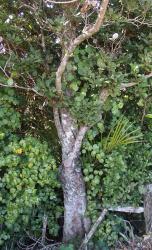- Taxon
- Gallery
- ≡ Laurus tarairi A.Cunn., Ann. Nat. Hist. 1: 379 (1838)
- ≡ Nesodaphne tarairi (A.Cunn.) Hook.f., Bot. Antarct. Voy. II. (Fl. Nov.-Zel.) Part I, 217 (1853)
Evergreen tree to 22 m tall; trunk to 1 m diam.; wood pale brown, straight grained; bark smooth, dark brown, often obscured by lighter coloured lichen growth; branching monopodial to give a crown of stout, spreading branches; branchlets, young leaves, petioles and inflorescence branchlets densely clad in reddish brown tornentum; leaves closely alternate, simple, coriaceous, on petioles (8-)10(-12)mm long; midrib stout, slightly sinuous, prominent above and below; leaf laminae wide-elliptic to wide-obovate, (37-)49-72(- 84) × (26-)34-47(-56) mm, dark green and glabrous above with impressed veins, glaucous below with stout veins covered in reddish brown tomentum, margins entire and revolute, apex rounded to retuse and mucronate, venation reticulodromous; inflorescence an erect, axillary panicle to 100 mm long but generally shorter, stoutly branched with dense clusters of flowers; floral bracts 2-3 mm long, lanceolate, with dense reddish brown tomentum; flowers perfect, on short pedicels, 3-5 mm diam. greenish (this colour sometimes obscured by dense reddish brown tomentum), perianth of 6 segments, stamens 12 (arranged as for genus), ovary unilocular and superior; drupes erect, ellipsoid to ovoid, (27-)31(-35) × (14-)16(-18)mm, 1-seeded, pericarp fleshy, dark purple when ripe, glaucous.
[Reproduced from Wright (1984, New Zealand J. Bot. 22: 109-125) with permission from The Royal Society of New Zealand.]
Flowering: Sep.–Dec.; Fruiting: Nov.–Feb.




